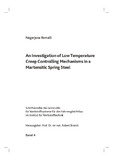Citation link:
http://dx.doi.org/10.25819/ubsi/10447| DC Field | Value | Language |
|---|---|---|
| crisitem.author.orcid | 0000-0002-0465-3696 | - |
| dc.contributor.author | Remalli, Nagarjuna | - |
| dc.date.accessioned | 2023-12-14T09:01:25Z | - |
| dc.date.available | 2023-12-14T09:01:25Z | - |
| dc.date.issued | 2023 | de |
| dc.description.abstract | The rising demand for electric vehicles urges automotive suppliers to push their limits on the sag resistance of suspension coil springs. However, the mechanisms contributing to sag loss in a coil spring or low temperature creep (LTC) in martensitic spring steel (MSS) are still unclear. Furthermore, the LTC rate-controlling mechanisms in MSS remain elusive. In the current research, an attempt has been made to unfold the LTC rate-controlling mechanisms in SAE 9254 steel grade. First and foremost, the LTC mechanism-based models, i.e. strain hardening theory (SHT), and exhaustion creep model (ECM) are developed to make them capable of describing the stress σ and temperature T dependent LTC strain of a material. Subsequently, the modified SHT and reworked ECM are verified and validated at the example of SAE 9254. The temperature-dependent LTC behavior of inductively quenched and tempered (IQT) SAE 9254 and martempered SAE 9254 are studied at the temperatures 298 K ≤ T ≤ 353 K for a duration of 1 hr at each condition. The stress σ dependent LTC behavior of IQT SAE 9254 is studied at the stresses 1071 MPa ≤ σ ≤ 1634 MPa, and the stress σ dependent LTC behavior of martempered SAE 9254 is studied at the stresses 421 MPa ≤ σ ≤ 632 MPa. A combined analysis by means of (i) the reworked ECM, and (ii) advanced microstructural characterization prior to and post LTC suggests that dislocation glide, mainly localized in the metastable retained austenite phase, is one of the basic LTC contributing mechanisms in SAE 9254. Stress-assisted martensitic transformation (SAMT) and, at elevated temperatures, strain-induced martensitic transformation (SIMT) are the additional LTC contributing mechanisms. Furthermore, the considered approach suggests that the LTC rate-controlling mechanisms are stress-assisted recovery (SAR), SAMT, and, at elevated temperatures, SIMT. | en |
| dc.description.abstract | Die steigende Nachfrage nach Elektrofahrzeugen zwingt Automobilzulieferer dazu, ihre Grenzen bei der Setzfestigkeit von Fahrwerksfedern zu erweitern. Der Mechanismus, der zum Setzverlust einer Fahrwerksfeder oder zum Low Temperature Creep (LTC) eines martensitischen Federstahls beiträgt, ist jedoch noch unklar. Darüber hinaus ist ebenfalls der Kriechraten kontrollierende Mechanismus im Tieftemperaturbereich nicht bekannt. In der aktuellen Studie wurde versucht, den Kriechraten kontrollierenden Mechanismus im Tieftemperaturbereich für die Stahlsorte SAE 9254 zu ermitteln. Zunächst werden die LTC-Mechanismusbasierten Modelle, d.h. die Strain Hardening Theory (SHT) und das Exhaustion Creep Model (ECM) weiterentwickelt. Anschließend werden die modifizierten LTC-Mechanismusbasierten Modelle verifiziert und am Beispiel der Stahlsorte SAE 9254 validiert. Es werden die mechanischen Eigenschaften des Inductively Quenched and Tempered (IQT) und martemperten SAE 9254 im Temperaturbereich von 298 K ≤ T ≤ 353 K für eine Stunde untersucht. Der überprüfte Spannungsbereich für das spannungsabhängige LTC-Verhalten liegt im Fall von IQT zwischen 1071 MPa ≤ σ ≤ 1634 MPa und im Fall des martemperten Stahl zwischen 421 MPa ≤ σ ≤ 632 MPa. Eine zusammenhängende Analyse mit Hilfe (i) eines mechanismusbasierten ECM und (ii) einer erweiterten mikrostrukturellen Charakterisierung vor und nach dem LTC legt nahe, dass das Versetzungsgleiten, welches hauptsächlich in der Restaustenit Phase stattfindet, ein grundlegender Mechanismus des LTC ist. Der hier vorgestellte Ansatz berücksichtigt die Stress Assisted Recovery (SAR) und die Stress-Assisted Martensitic Transformation (SAMT) für niedrigere Temperaturen sowie die Strain- Induced Martensitic Transformation (SIMT) bei erhöhten Temperaturen als Kriechraten kontrollierenden Mechanismus. | de |
| dc.identifier.doi | http://dx.doi.org/10.25819/ubsi/10447 | - |
| dc.identifier.uri | https://dspace.ub.uni-siegen.de/handle/ubsi/2660 | - |
| dc.identifier.urn | urn:nbn:de:hbz:467-26604 | - |
| dc.language.iso | en | de |
| dc.relation.ispartofseries | Schriftenreihe des Lehrstuhls für Werkstoffsysteme für den Fahrzeugleichtbau im Institut für Werkstofftechnik | de |
| dc.subject.ddc | 620 Ingenieurwissenschaften und zugeordnete Tätigkeiten | de |
| dc.subject.other | Low temperature creep | en |
| dc.subject.other | Martensitic spring steel | en |
| dc.subject.other | Retained austenite | de |
| dc.subject.other | Dislocation glide | en |
| dc.subject.other | Phase transformation | en |
| dc.subject.other | Tieftemperatur-Kriechen | de |
| dc.subject.other | Martensitischer Federstahl | de |
| dc.subject.other | Versetzungsgleiten | de |
| dc.subject.other | Phasenumwandlung | de |
| dc.subject.swb | Federstahl | de |
| dc.title | An investigation of low temperature creep controlling mechanisms in a martensitic spring steel | en |
| dc.title.alternative | Eine Untersuchung der Mechanismen zur Kontrolle des Kriechens bei Tieftemperaturen in einem martensitischen Federstahl | de |
| dc.type | Doctoral Thesis | de |
| item.fulltext | With Fulltext | - |
| item.seriesid | 74 | - |
| ubsi.contributor.referee | Brandt, Robert | - |
| ubsi.date.accepted | 2023-11-23 | - |
| ubsi.organisation.granting | Universität Siegen | - |
| ubsi.origin.dspace5 | 1 | - |
| ubsi.publication.affiliation | Institut für Werkstofftechnik | de |
| ubsi.relation.issn | 2700-7529 | - |
| ubsi.relation.issuenumber | 4 | de |
| ubsi.subject.ghbs | ZLQ | de |
| Appears in Collections: | Hochschulschriften | |
Files in This Item:
| File | Description | Size | Format | |
|---|---|---|---|---|
| Dissertation_Remalli_Nagarjuna.pdf | 32.3 MB | Adobe PDF |  View/Open |
This item is protected by original copyright |
Page view(s)
578
checked on Apr 4, 2025
Download(s)
83
checked on Apr 4, 2025
Google ScholarTM
Check
Altmetric
Items in DSpace are protected by copyright, with all rights reserved, unless otherwise indicated.

